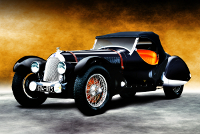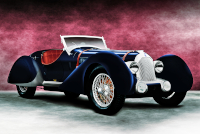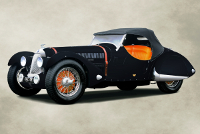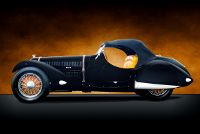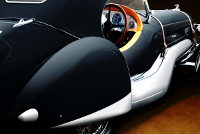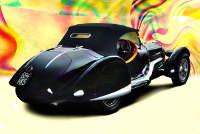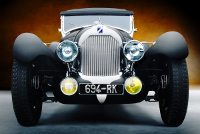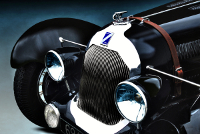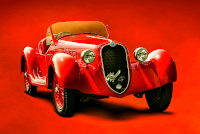Location:
St. Michaels Concours d'Elegance, 2008
Owner: James A. Patterson | Louisville, Kentucky
Prologue:
Image Source: Nikon D200 (10.2) MP
Image 2 is a reverse of photo 1 illustrated to depict chassis #82928 as it appeared at the 1937 Paris Salon, although the choice of sapphire paint is mine.
References:
- RM Magazine, July 2005, "Talbot Lago and the 1937 T150-C SS Competition Roadster" by Norm Mort, page 46-49
- RM Magazine, July 2005, "Restoring a Talbot" by Norm Mort, page 50-51
- UltimateCarPage: Technical specifications based on this resource, then vetted using RM material. Note that on this site the car is erroneously referred to as #90110, which I believe is a teardrop coupe.
- Coachbuild.com: A brief is accompanied by numerous photographs, including three copies of some of my old versions.
- Sunbeam.org: A pleasant, illustrated summary of the early anglo-franca Talbot company.
Is #82928 an original factory competition car, a luxury super sports built on one of six competition chassis? The chassis number could be low enough to substantiate that claim, and upon restoration RM found that the chassis and many of the car's mechanical components had been drilled in an effort to make it as light as possible. RM reports the motor is very responsive, as a high-compression setup should be, and that the steering is geared to be exceptionally quick, like a competition car. In any case, this chassis has appeared in various configurations since its birth, and I am depending on RM's information to confirm that all the old pictures and references are of the same car.
Chassis #82928 was shown at the Paris Salon in 1937—see photograph 3 in this set. At the time, the car wore dark paint and a pair of smooth front fenders that fully enclosed the insides of the wheels. But then reference photos from the car's first owner, a Parisian by the name of B. Alsan-Finlay, show a car wearing a light shade of paint with numerous changes throughout the body. When restoration at RM began in the early 2000s, the car looked very much like it had in Paris, but included the second set of fenders seen at the time of its first owner. RM's restoration replicates those features of the car as delivered to B. Alsan-Finlay, although the level of finishing befits a luxury super sports more than a lightweight racing car. Thus the result is quixotic, a lithe sports racer polished to show car refinement.
Luigi Chinetti, best known for his work with Ferrari in the post-War era, was closely aligned with Talbot-Lago. Chinetti was both businessman and racing supporter, serving as the marque's distributor while also running a racing team. According to correspondence from Mssr. Alsan-Finlay, Chinetti delivered chassis #82928 personally. Alsan-Finlay offered the car for Chinetti to have a run at Montlhéry, site of the 1937 French Grand Prix, but whether this arrangement materialized remains unknown.
Giuseppe Figoni's forté was touring cars, with modest beginnings comparable to the work of Castagna. Clothing an ex-racer in a svelte roadster body would have been a very different assignment, and RM cites the firm's lead designer, Jean Andreau, as the party responsible. Andreau can be termed an early aerodynamicist, albeit one whose theories in speed were adapted to the prevailing style of the decade. My personal opinion is that the Paris design bears more resemblance to Andreau's style, and that the Alsan-Finlay configuration is a sporting deconstruction based on the owner's desire to race the car.
Motor: 3,994 cc straight 6-cylinder, cast iron block, aluminum hemi-head | 90 mm x 104.5 mm | 7.0:1 compression
Valvetrain: overhead valve, 2 valves per cylinder
Aspiration: triple Stromberg carburetors
Power: 170 bhp @ 4,100 rpm (rated 140 bhp)
Drivetrain: Wilson 4-speed preselector gearbox, rear-wheel drive
Front Suspension: independent with wish bones, transverse leaf springs, and friction dampers
Rear Suspension: live axle with semi-elliptic leaf springs and friction dampers
Architecture: steel box-section chassis with aluminum coachwork by Figoni et Falaschi of Paris
Kerb Weight: 1,250 kg (2,755 lbs)
Wheelbase: 2,650 mm (104.3 inches)
Top Speed: 193 km/h (120 mph)
Etymology:
The 'T150' designation carries over an old progression that began in the last days of the original Talbot, specifically with the Talbot 90 and 105, which signified the marque's sporting intentions. After company ownership passed from Rootes to Anthony Lago, the number series was continued with the 120, which engineer Walter Becchia developed based on older plans. While the designations of cars from this era often reference power output, or even taxable power, it is likely that the numbers of the Talbot T-series are references to theoretical top speed in stripped down racing form. Well known is that the 'C' designation is shorthand for 'competition,' denoting that the car was prepared with various racing components. The 'SS' designation is shorthand for 'super sports,' which is the Talbot-Lago equivalent of a grand touring car, or a proper 'GT' in modern parlance. The car's body was built by famous Parisian firm Figoni et Falaschi, while the chassis number is also included in our title.
Figures:
Chassis #82928 is most likely one of about 30 short-chassis cars produced for well-healed customers who fancied both sport and luxury. There is a slight chance the chassis is one of six competition cars, with the original body shuffled to a different chassis, thence rebodied for a private customer. But it seems more likely that #82928 is the equivalent of the T150-C SS cars, which include the teardrop coupes. In any case, while Figoni et Falaschi may have crafted one other body in this design, no other such car is known to exist today.
Images 3 and 4 compare apart the differences between the Paris Salon coachwork and the sporting coachwork as fitted for first owner, Monsieur B. Alsan-Finlay.
Paris Salon: T150-C SS Coachwork Prepared for the 1937 Paris Salon
Familiar cues of Jean Andreau define the Paris coachwork. Fenders mimic those of the T-150 C SS Coupe—the famous teardrop. Fast and tidy, extravagant without being cluttered, the Paris bodywork uses elements that would have been immediately recognizable under the Figoni et Falaschi trademark. Front and rear fenders are elongated, and the chrome flashing on the rear mimicks that of the teardrop coupes, with a dart that fits closely against the body, aft of the door. Polished headlamps reside deeper in the fascia, and the grille shroud forms a three-piece ensemble with two separate plates surrounding each of the lower driving lights. The sidepipe did not appear to use a shroud, resting much closer along the flank, and the rear deck did not include the long chrome rails seen today. However, another mark of Andreau, the rear deck featured a short dorsal fin, extending halfway down the boot lid. In all likelihood, the Paris Salon car was painted black, although for my tastes a deep sapphire color looks striking, particularly matched with upholstery that appears as if it were more in the range of red.
Alsan-Finlay: T150-C SS Coachwork As-Delivered
Alsan-Finlay: When delivered to B. Alsan-Finlay, chassis #82928 appeared more along the lines of a pure sports car—demonstrating beauty without pretentiousness. The front fenders are replaced with a slimmer, cycle-style pair. That the front wheels now open beneath the fenders necessitates a revised front cowl section, omitting the two harlequin-style chrome plates around the driving lights and redesigning the lower portion of the grille shroud into a point that curves under the bodywork. The headlamps move forward and gain body-matched pods. A new set of rear fenders is truncated, with the chrome darts separated from the body, curving in toward the seam behind the door while departing out on a blade-like tangent across the wheel skirt. On the exhaust side, a large shroud covers the sidepipe, surely a practical addition, and the rear deck gains a set of chrome rails. Upon delivery, the car was painted a light color, with what appear to be painted wire wheels. My bogus internet research suggests the car was India green with straw yellow wheels, something I'd like to depict as it sounds like a bright, beautiful combination.
Present Day T150-C SS Coachwork:
RM started with a car built upon the Paris Salon configuration, but that also included the cycle fenders from its days with Mssr. Alsan-Finlay. The car has since been returned to its as-delivered configuration, although the finishing befits a motor show car more than a racer. This mix of competition body and supersports luxury is curious, and why the car uses polished wheels and glossy black paint can only be answered by prevailing concours d'elegance trends at the time of its restoration. But the body of 82928 is less like its Figoni et Falaschi cousins, and more like a BMW 328 in proportion and purpose. Particularly in period photographs, Alsan-Finlay's car appears ready to drive, with its flip-down screen and darting stance. So if we were to be critical, we'd say the restoration overshoots the goal—that if the Paris Salon car were rebuilt, then one could justify the glitz.
Differences aside, the present day car is far too delectable to critique; it has always been one of my personal favorites, both from an aesthetic standpoint and from the perspective of cars I would love to drive home. I know of no other car like it in the world, and don't mind that the current iteration blends show car origins with race car aspirations. And I rather think that's the charm of this short-chassis T-150 C, that one could keep changing the panels and the colors and the nuances, and any resulting configuration would look stellar.
Last Updated: Feb 13, 2025

